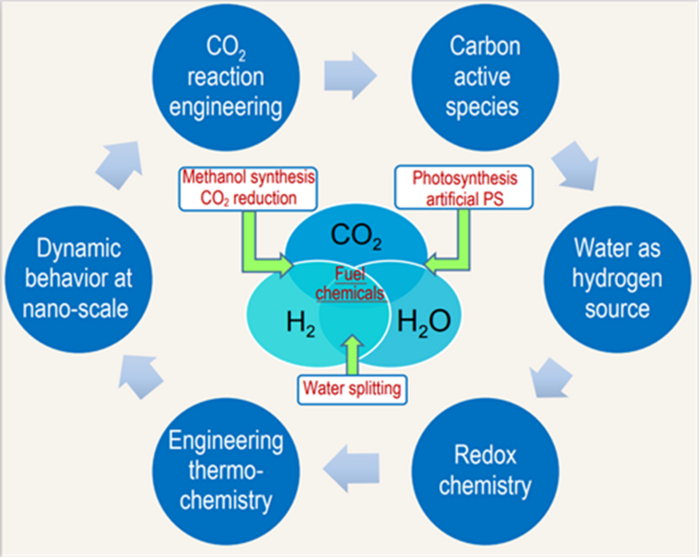Carbon is an essential element in the formation of living beings. The carbon energy system, which involves biomass, permitted the ancestors of humans to quit when they consumed raw birds and animals and join the age of carbon civilization.
 The fundamental aspects of green carbon science include carbon active species, water as hydrogen source, redox chemistry, engineering thermochemistry, dynamic behavior at nano-scale, and CO2 reaction engineering. These six aspects are centered on a tri-molecular system of CO2, hydrogen, and water. In a carbon energy system with carbon-neutrality, the CO2 can be recycled by chemical and ecological pathways via methanol synthesis and photosynthesis/artificial PS, respectively, while the hydrogen is acquired from water splitting. Image Credit: ©Science China Press.
The fundamental aspects of green carbon science include carbon active species, water as hydrogen source, redox chemistry, engineering thermochemistry, dynamic behavior at nano-scale, and CO2 reaction engineering. These six aspects are centered on a tri-molecular system of CO2, hydrogen, and water. In a carbon energy system with carbon-neutrality, the CO2 can be recycled by chemical and ecological pathways via methanol synthesis and photosynthesis/artificial PS, respectively, while the hydrogen is acquired from water splitting. Image Credit: ©Science China Press.
The functioning of the carbon energy system produces carbon dioxide, which creates the greenhouse effect that allows life on Earth to exist. One could argue that life cannot exist without carbon and cannot endure without carbon dioxide. The key elements in terms of carbon are balance and recycling.
Lao Tzu’s “Tao Te Ching” (571–471 B.C.) is one of the most profound works of ancient philosophy ever written. As stated there, “Tao produces one. One produces two. Two produce three. Three produce myriad things. Myriad things, backed by Yin and embracing Yang achieve harmony by integrating their energy.”
Here, “Tao” refers to the universe and its laws in a simplified common understanding. In accordance with Tao, the carbon energy that scientists are investigating in the field of green carbon science can be regarded as one.
Taoism emphasizes the duality of all things in nature; the white section of the universe represents Yin, or the Negative, and the black region represents Yang, or the Positive. Two complementary halves are always competing against one another since one cannot exist without the other.
When the carbon energy system is mentioned as one, the two opposite counterparts that make up its core, oxidation and reduction, can be taken as two, and the three elements that make up the carbon energy system—carbon, hydrogen, and oxygen—and efficiently carry out all oxidation-reduction reactions, can be taken as three.
Numerous reactions and molecules can be formed based on the three components carbon, hydrogen, and oxygen. Thus, three can yield a wide range of results. The molecules generated could then interact with one another to produce a number of new reactions and a wide range of new products.
The trilemma between economic growth, resources, and the environment can help people grasp the concept of green sustainable development. The concept of “green carbon science” can be viewed in terms of the trilemma between economic growth, carbon energy, and carbon dioxide by replacing resources with carbon energy and the environment with carbon dioxide.
To build a new energy system with the objective of carbon neutrality, knowledge will be updated and technology will be innovated at the molecular level, including processing via molecular pathways, new routes of molecular synthesis, and the production and manufacturing of new molecules, among other things. A basic scientific review of the issues involved in green carbon science is presented.
Journal Reference:
He, M., et al. (2023). Green carbon science: fundamental aspects. National Science Review. doi.org/10.1093/nsr/nwad046.